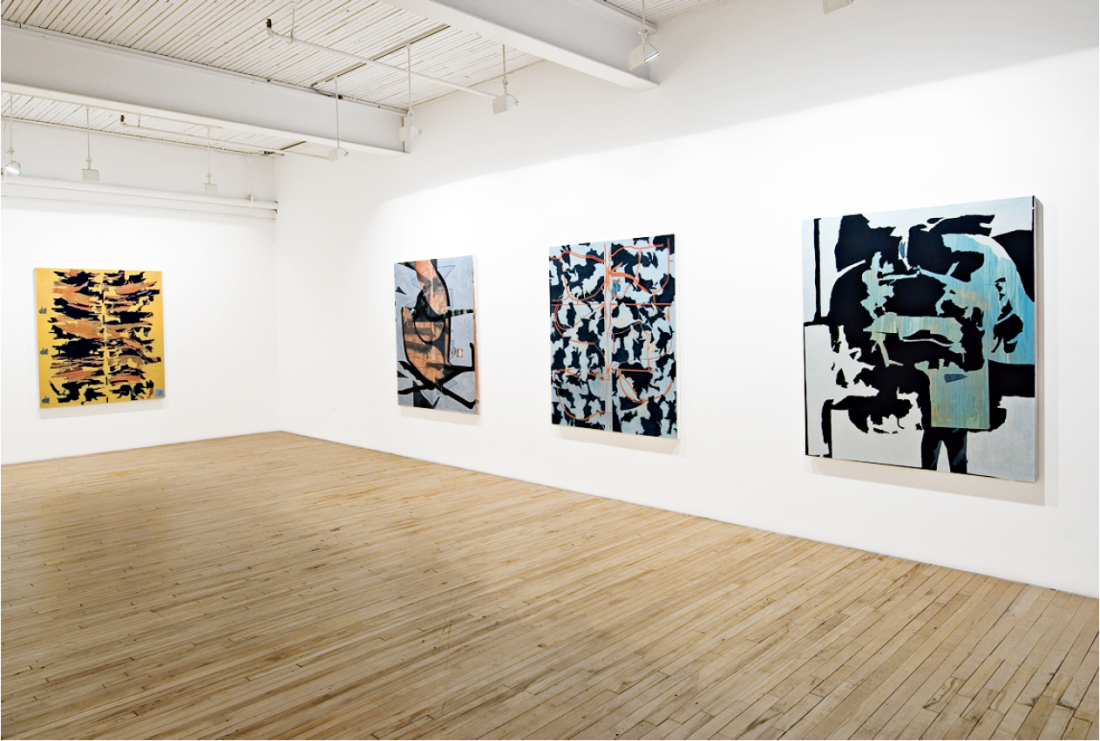Krisjanis Kaktins-Gorsline
In the works exhibited here, Krisjanis Kaktins-Gorsline performs on his own paintings a crisp and deft trepanning. He makes process an overt subject matter by taking motifs from his paintings and replicating them over and over again in their ongoing facture. The stencils derived from gestures in a given painting are thus integral to each successive painting, where the stencils marry with one another and with new gestures to generate new shapes that then become new stencils. Each painting is layered with a host of processual precursors, and an ever-higher order of evolutive complexity. In so doing, Kaktins-Gorsline opens painting to issues of ornamentation, and the motifs in question become a default template for painting, almost mathematical in its mien. Certainly, pattern and ornament in these works are binary unifying themes.
These unifying themes, however, as is so often the case in advanced painting, effortlessly transcend the artist’s own operative intention. Beyond the ornament, they mark the canvas-bound intersection of the Rorschach test, the Mandelbrot set, and nerve signaling in the human brain. The Rorschach test (also known as the Rorschach inkblot test) is a psychological test. Those taking the test have their perceptions of inkblots recorded and subsequently analyzed using both psychological interpretation and complex algorithms.

Krisjanis Kaktins-Gorsline, Nervous Lattice, 2011, oil on canvas, 147 x 122 cm. Images courtesy the artist and Battat Contemporary, Montreal.
When I first viewed Kaktins-Gorsline’s paintings, I experienced a curious frisson: their ambiguous designs reminded me tangentially of the works of Jacques Hurtubise, the legendary Quebec abstract painter whose work, some critics claimed, was related to Rorschach blots. But there was no overt stylistic similarity. The kinship was at the level of the repeated motif and a higher order of complexity. Kaktins-Gorsline’s paintings are even more potent as projection zones than those of Hurtubise: they have thematized gaps that lure us inside his own process. The process motifs have more to do with our own reading of the paintings, our own emotional functioning, as it were, while at the same time demonstrating an evolving complexity in terms of form. The symmetrical integuments in a Hurtubise painting here morph beyond the Rorschach blot into stranger territory still.
Indeed, the Rorschach likeness leads us inevitably to the Mandelbrot set, a fractal mapped on an xy-coordinate grid. It is precisely this question of increasing complexity, triggered by the rollover of his motifs in a way that segues not only with the artist’s interest in the evolution of biological systems but as a fractal across the entirety of the original plane. The framing edge seems a physical rather than imaginative limit to an elaborate boundary that reaches outside painting and snakes its way into our own heads. This is certainly the case with Nervous Lattice, 2011. The Rorschach-like motifs seem genetic, and unfold in truly fractal fashion, while each vector of the painting is interconnected with serpentine lines suggestive of synaptic firing sequences. This is an exalting order of combinatorial play.
The Mandelbrot set (named after maverick mathematician Benoît Mandelbrot, d. 2010) is a mathematical set of points in the complex plane, the boundary of which forms a fractal. Visual representations of fractal geometry bear a startling parallel to Kaktins-Gorsline’s ambiguous and quasi-figural abstracts. The exfoliation and repetitive use of their motif structures lead to seeing a clear and present relationship to the geometry of fractals.

Installation view of “Nervous Lattice,” 2012, Battat Contemporary, Montreal.
The Mandelbrot set leads us to nerve signalling in the human brain; Kaktins-Gorsline’s title for his show, “Nervous Lattice,” certainly seems an overt reference to nerve endings, neural wiring and overwriting. Arguably, these recent paintings asked viewers to find what they have in common with Charles Scott Sherrington’s pet cat. (Not Schrodinger’s cat, mind you, but that of Sherrington, the man who in 1897 gave the synapse its name.) Sherrington revealed how nerve impulses coordinate movement. The Eureka!-shriek behind this discovery came from watching his cat walk leisurely along a wall, then jump neatly over a gap so as to continue its walk unperturbed. How did the cat manage this remarkable feat—judging the breadth of the gap and landing so precisely? Sherrington understood that a mass of nerve signals from different neurons made it possible. We project in and through the gaps in Kaktins-Gorsline’s paintings in much the same way, and it is no exaggeration that their microstructures are much like synaptic diagrams.
The “Nervous Lattices” works are painterly and experimental and entirely winning. Their radical openness lends them an unusually kinetic and magnetic pull and, as they succeed one another across the length and breadth of the Battat Contemporary gallery space, they demonstrate a strange kinship with Sherrington’s cat. ❚
“Nervous Lattice/Treillis Nerveux” was exhibited at Battat Contemporary, Montreal, from January 19 to February 25, 2012.
James D Campbell is a writer and curator living in Montreal who contributes regularly to Border Crossings.

